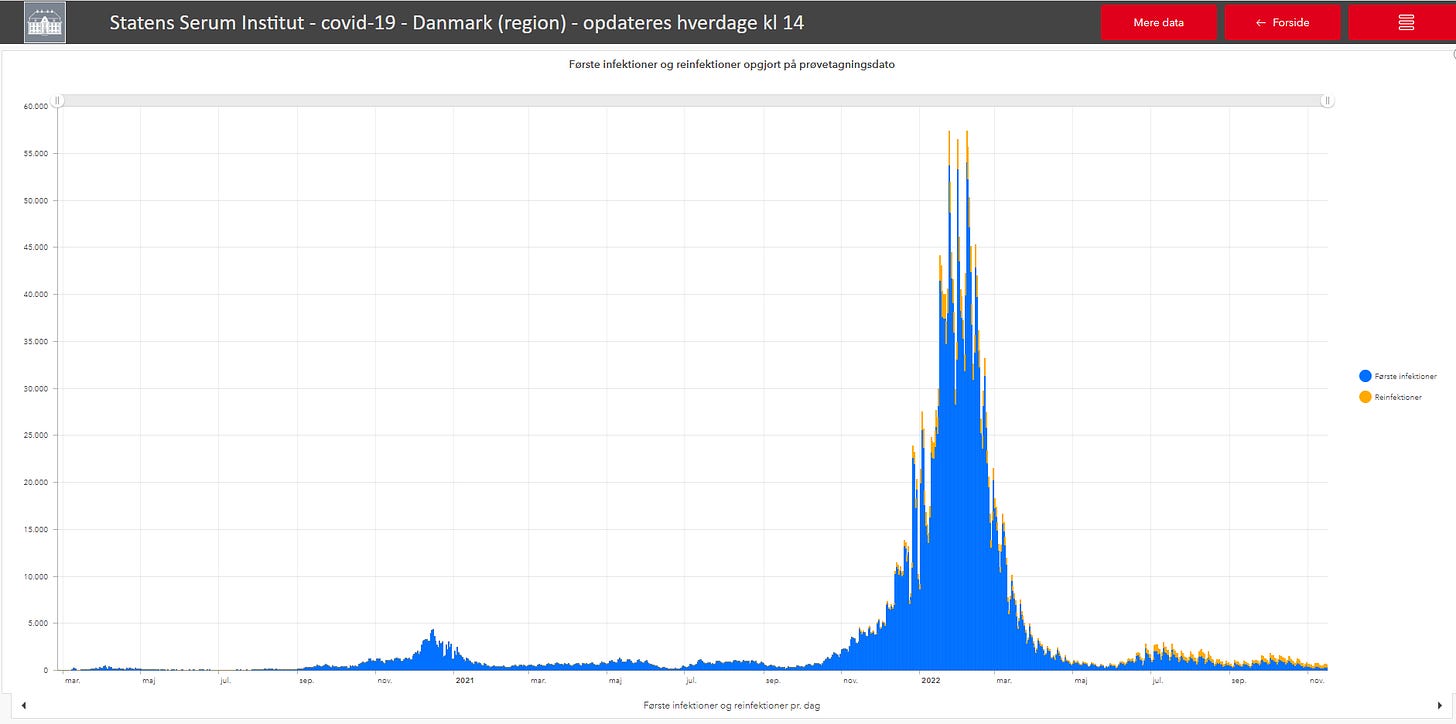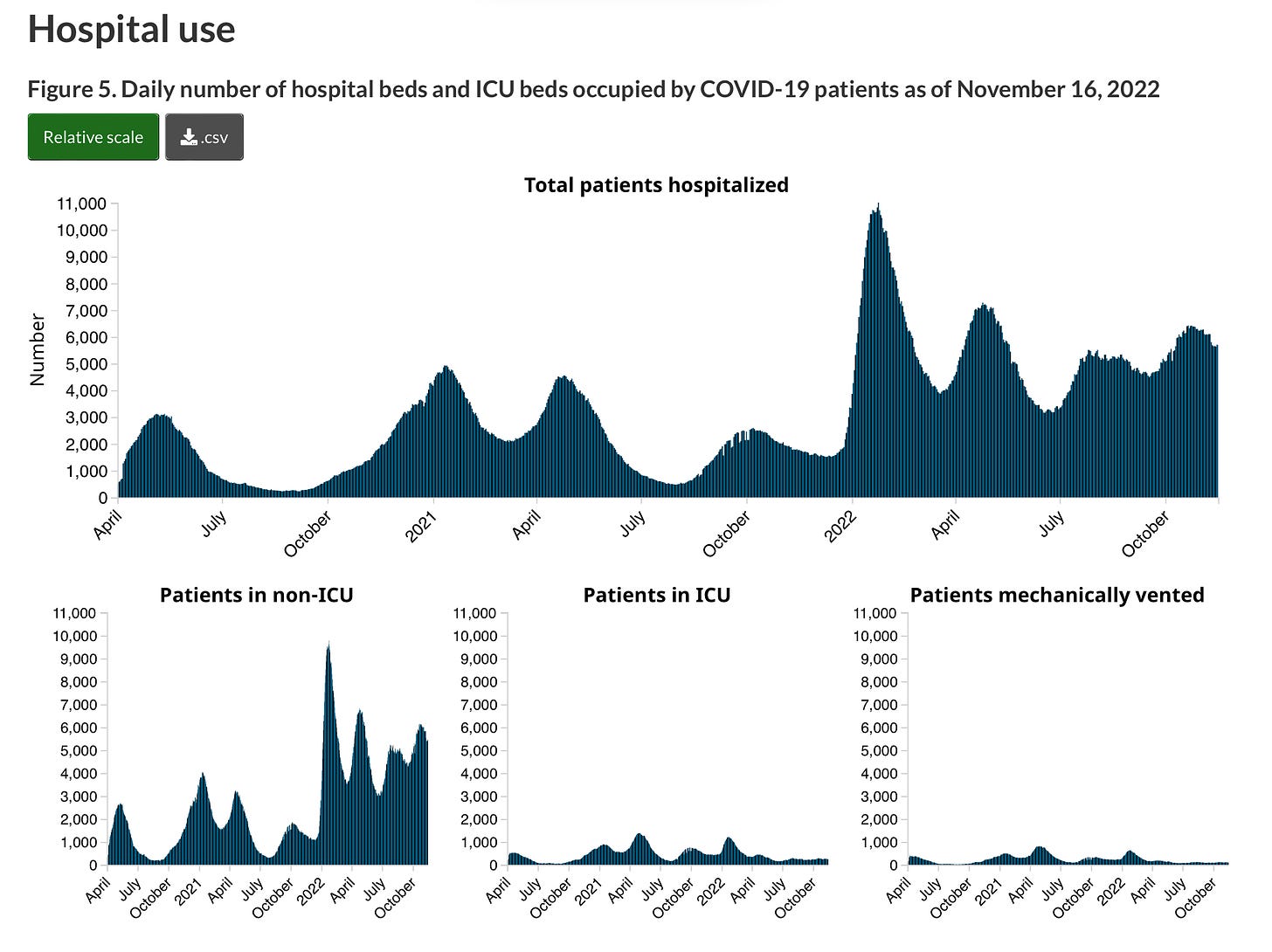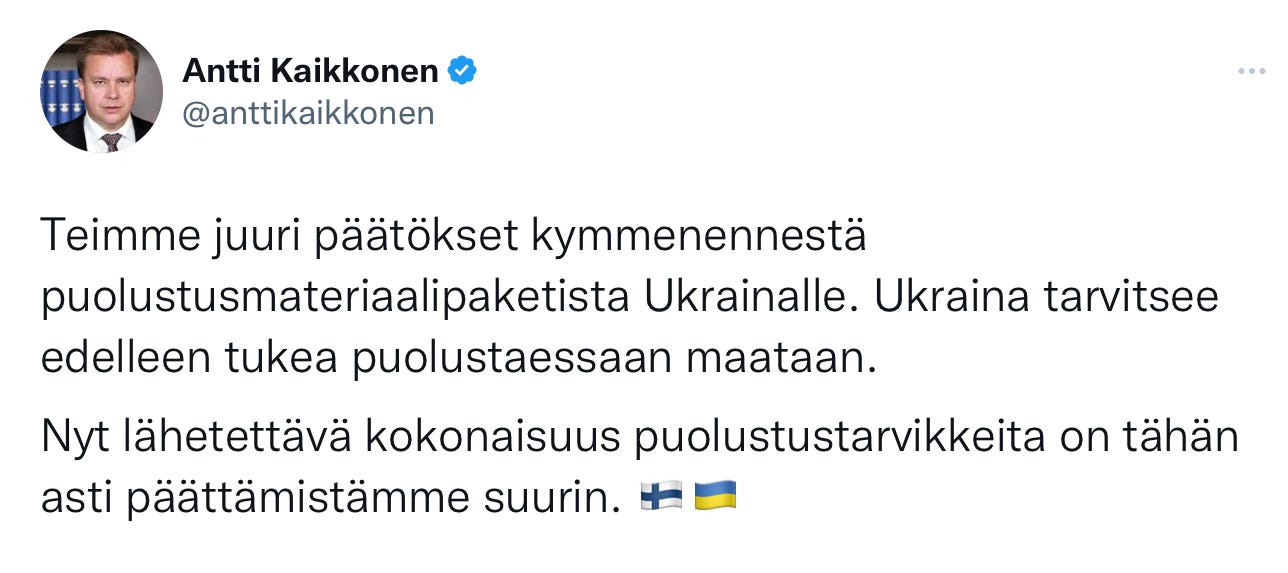The Evening Report - Nov 17
Norway warns virus waves could strain hospitals. Denmark’s epidemic levels off.
🚨🚨
A third scenario is emerging in the case of the two missile strikes that crossed the Ukrainian border into Poland, killing two people. The United States, NATO, and even Poland’s President all say it is very likely that both missiles were Ukrainian. In this scenario, the missiles were fired to intercept incoming Russian rockets and somehow went astray exploding on impact across the Polish border.
All of the countries and NATO who are saying this is the more likely scenario are taking pains not to blame Ukraine, saying it is still Russia’s fault because it wouldn’t have happened if Ukraine hadn’t been trying to fend off a barrage of Russian missiles.
For its part, Ukraine remains skeptical, insisting the two rockets are more likely Russian. Ukraine’s Foreign Affairs Minister Dmytro Kuleba says Ukrainian investigators are now in Poland.
It is worth noting that NATO had surveillance planes in the air, as it has for most of the conflict, and at least one plane tracked the missiles entering Polish airspace. The telemetry data has been handed over to NATO officials.
Poland has backed down from any efforts to try and invoke NATO article 4, and concerns the military alliance could be dragged into the conflict have eased a little.
🦠Pandemic🦠
🇩🇰
The COVID situation in Denmark seems to be more or less treading water, according to the latest weekly pandemic assessment from the Statens Serum Institute. Overall, the latest batch of statistics is a bit of a mixed bag.
After four weeks of falling infection numbers, an unreliable statistic, case numbers treaded water last week. The number of PCR tests taken, which had also been declining, has also leveled off week to week. Nationally, the positivity percentage last week was 12%, pretty much where it was the week prior.
Looking at it by region, two of the five Danish regions, Region Midtjylland and Region Syddanmark, both saw a decline in the COVID incidence rate. Conversely, the other three regions saw the incidence rate rise. Region Sjælland continues to have the highest rate (98 per 100,000 people). The lowest (64) was in Region Midtjylland, which oddly also had the highest positivity percentage at 14%.
A week after corona cases dropped across all age groups, last week infections rose among infants two years old and younger, six to 15 years old, and those 20 to 49 years old. For a second week in a row infection activity was highest among those 40 to 49 years old, notably the age group just outside those eligible for a 4th dose. Six to 24 year olds had the highest positivity percentage at 16%.
Among vulnerable seniors in care infections fell for a seventh straight week. Although the positivity percentage remains at 2.8%. There were nine deaths among seniors in nursing homes in week 45, the same number as the week before. However, among senior care staff after five weeks of dropping infection activity, COVID cases rose last week.
COVID hospitalizations have fallen for a fourth straight week. There were 275 new admissions last week, 48 fewer than the week before. As has been the case all year, seniors 70 to 89 years old continue to make up the largest proportion of new infection-related hospital admissions. There were just 12 intensive care admissions last week.
Pandemic deaths really dropped week to week, with 38 lives lost last week after 62 deaths the week prior.
The BA.5 variant, or, more accurately, the variant and a cluster of its sub-variants, remain dominant in Denmark. But, the SSI says the BQ.1 (17%), BQ.1.1 (6%), and XBB (5%) variants continue to gain ground.
COVID wastewater surveillance shows virus activity sharply dropping nationally. Among the five regions, coronavirus activity also fell. The BQ.1 variant made up 29% of all sequenced wastewater testing results last week.
-
COVID hospitalizations (273) continued to drop (-20) while the number of severe coronavirus infections in an ICU (10) crept upward (+1) of those, the number on a ventilator (3) was unchanged day to day.
Infection admissions to a psychiatric institute (71) were also unchanged.
-
Denmark has reported 574 COVID infections (underreported), including 272 reinfections, and one more coronavirus death in the last day.
Yesterday, there were 6,773 PCR tests equaling a positivity percentage of 8.47%, over the last seven days; the rate is 11.87%.
-
Denmark’s vaccine booster dose campaign has so far inoculated 30.3% of the total population, and among the target group, those 50 years old and older, 71% have had a 4th dose. For seniors 85 years old and older the vaccination rate is 85%. While, 87.9% of nursing home residents have received a booster vaccination.
-
The Statens Serum Institute’s sentinel monitoring shows that RS virus, rhinovirus, and the coronavirus were the three most detected respiratory viruses detected in week 43.
🇸🇪
Sweden added 4,102 infections (wildly underreported) and 71 more corona deaths in the last seven days.
COVID hospitalizations (773) have jumped (+94) ICU numbers (18) also crept up (+3).
To date, 88.2% of those 18 years old and older have one vaccine dose, 86.4% have two, 66.5% have one booster dose, and of those 65 years old and older 80.1% have a 2nd booster.
🇳🇴
The Norwegian Institute of Public Health has stopped reporting daily COVID statistics in favour of a weekly report combining coronavirus, influenza, and other infection activity.
-
In its latest weekly pandemic update, Norway’s national health agency says infections and hospitalizations have increased, albeit just slightly, week to week, while COVID deaths have decreased. Overall, the agency says a new infection wave has arrived and it is being complicated by rising numbers of influenza and RS virus infections. It warns that hospitals are going to be strained.
“The burden on hospitals could be great. Health institutions must be prepared for more admissions, more outbreaks, and for more staff to be calling in sick.”
The Norwegian Institute for Public Health says new COVID variants that are much better at dodging immunity are driving infection numbers upward. It says rates of BQ.1 variant infections in particular are rising.
The NIPH says the number of hospital admissions directly because of a coronavirus infection has been “relatively stable” over the last two weeks. Last week, there 196 admissions, three more than the week previous. ICU admissions have also been fairly stable for 11 weeks and counting. Last week, there were eight severely infected people in intensive care, one less than the week before.
COVID hospitalizations by age/ NIPH
Visits to either an emergency room or a family doctor due to a COVID infection both increased slightly last week.
Norway lost another 39 lives to the pandemic last week, down from the 46 deaths recorded the week before.
COVID wastewater surveillance in Norway, which is fairly limited covering about 30% of the population, showed a decline in virus activity last week. Increasing coronavirus rates had been recorded in each of the four preceding weeks.
The number of corona outbreaks in hospitals and other healthcare facilities is rising in Norway. There were 23 outbreaks recorded last week compared to 19 the week prior.
The number of weekly coronavirus infections has almost doubled since the first few weeks of October. Last week, there were 890 infection cases, a slight increase from the previous weeks 880. In all cases the numbers are underreported.
The Norwegian booster dose campaign has inoculated 69% of vulnerable seniors 75 years old and older. Among those 65 to 74 years old, the vaccination rate, as of last week, was 59%.
🇫🇮
Finland has registered 12,003 infections and 260 more virus deaths in the last seven days.
COVID hospitalizations (920) have dropped (-70).
So far, 79.6% of the total population has one dose, 76.7% have two, 54.2% have a booster, and 18.9% have a 2nd booster.
🇩🇪
Germany recorded 33,306 infections while suffering 162 pandemic deaths on Wednesday.
It added another 1,429 hospitalizations, while ICU numbers (1,017) eased slightly (-26). As a percentage of all intensive care beds in the country, COVID patients are using 4.8%.
So far, 77.9% of the total population has one dose, 76.3% have two, and 62.4% have a booster shot.
💉🌏
Pfizer BioNTech announced on Thursday that phase 1 clinical trials have begun for a new COVID vaccine candidate called BNT162b4. This new formulation is trying to enhance t-cell responses in order for more long lasting immune protection against the coronavirus. The two companies said that hope is that not only will this next generation vaccine provide longer-lasting protection but also broaden protection to cover a swath of COVID variants.
🇨🇦
COVID hospitalizations fell across Canada in the week ending November 16. The overall number of beds used by a coronavirus-infected patient dropped by 398 to 5,702 total beds in use. Among general admissions, the number of infected patients fell to 5,450, a drop of 382 compared to the seven days previous. Intensive care numbers also declined albeit not as dramatically, with 16 fewer ICU beds in use. Of the most severely infected who required a ventilator, there were 105; a drop of 16.
-
Health officials across the provinces are urging people to do everything they can to minimize infections spread as respiratory infections overwhelm hospitals. Canada is being hit with a virus cocktail from COVID, influenza, the RS virus, and others.
🇺🇦/ 🇷🇺 War
🇫🇮/ 🇺🇦
Finland’s Defense Minister says a 10th weapons package, and the largest Finland has sent yet, to Ukraine has been approved and is on its way.
Finland traditionally doesn’t reveal what their weapons shipments to Ukraine contain or any delivery details.
🇸🇪/ 🇺🇦
Sweden is also sending its largest weapons package to Ukraine to date. In all, Sweden will send Ukraine 3 billion Swedish kroner (about $382 million Cdn) worth of arms and equipment. While the Swedish government won’t reveal specifics the package will include ammunition and an air defense system.
🇩🇰/ 🇺🇦
30,807, that is how many Ukrainian refugees have arrived in Denmark since the Russian invasion of their homeland. The latest update from the Danish Immigration Service says that is how many residency permits to Ukrainian refugees have been issued since the spring.
As for housing, there is a fairly even spread of Ukrainian refugees seeking a home across the 98 Danish municipalities. As can be expected Metro Copenhagen has the most with 2,593 Ukrainians having searched for a place to live in the city.
Employment and Integration Mayor Jens-Kristian Lütken told Ritzau the influx of a Ukrainian refugees in to Copenhagen has been a challenge.
“The empty facilities that we have had, such as closed care homes, we have put into use. It is getting difficult to pull more [housing] out of the hat.”
🇪🇺/ 🇷🇺
An interesting vote looms in the EU next week. The European Parliament has agreed on the wording for a resolution that, if passed, would designate Russia as a state sponsor of terrorism. The resolution itself will be tabled for a vote next week.
🇪🇺
The number of illegal border crossings into the European Union has soared so far this year, according to preliminary figures released by Frontex, the EU’s border agency. It says in the first ten months of the year there were 281,000 illegal crossings into Europe, a 77% year-over year increase. The agency says that is also the highest number of border crossings recorded since 2016.
In October alone, EU countries saw 42,000 illegal crossings, a 71% increase from October of 2021.
Frontex says the route through the western Balkans is the most active for illegal crossings. This could be a reflection of Russians fleeing conscription after land borders to EU countries were closed.
The EU border agency says an almost equal number of Ukrainians entered the European Union as did return home over the past week. The agency says 221,177 Ukrainians returned from Europe back to their home country last week, compared to 221,386 who left Ukraine for various European destinations.
⚡️Energy Crisis⚡️
🇩🇰
The gusting winds have helped drive wind energy production in Denmark to record setting levels. On Wednesday, Energinet says preliminary numbers show wind energy production broke records.
Senior Business Developer Jesper Kronborg Jensen spoke to DR:
“It is not surprising that in Denmark we continuously experience new records being set for the production of renewable energy in light of the fact that more wind turbines and solar cells have been installed over the years.”
On Wednesday, 135,774 MWh of renewable energy was produced, roughly about 117% of the all of Denmark’s electricity consumption. All but 472 MWh was wind power, with the rest being solar.
While the wind is good for green energy production, November has not been a banner month for producing solar energy with just 20.8 hours of sunshine so far.
🇮🇹 🇸🇮/ 🇩🇿
As Russia weaponizes its natural gas exports in a bid to punish Europe for its support for Ukraine, Algeria is jumping in to try and fill the energy void. With the EU and its member states struggling to establish energy security while severing all reliance on Russian gas, Algeria has signed a new gas deal with Slovenia. The gas will travel through Tunisia and Italy on its way to Slovenia. The deal is good for at least the next three years.
Algeria has also signed a new gas agreement with Italy. As Algeria seeks to pick up the European gas market that Russia has surrendered out of spite, its deal with Italy will be one litmus test. Italy has pretty much topped up its gas storage facilities, but lately it has begun withdrawing gas from its storage tanks at a rate much faster than any other major European economy. Europe will be watching closely to see if Algeria can reliably meet Italy’s energy needs.




















